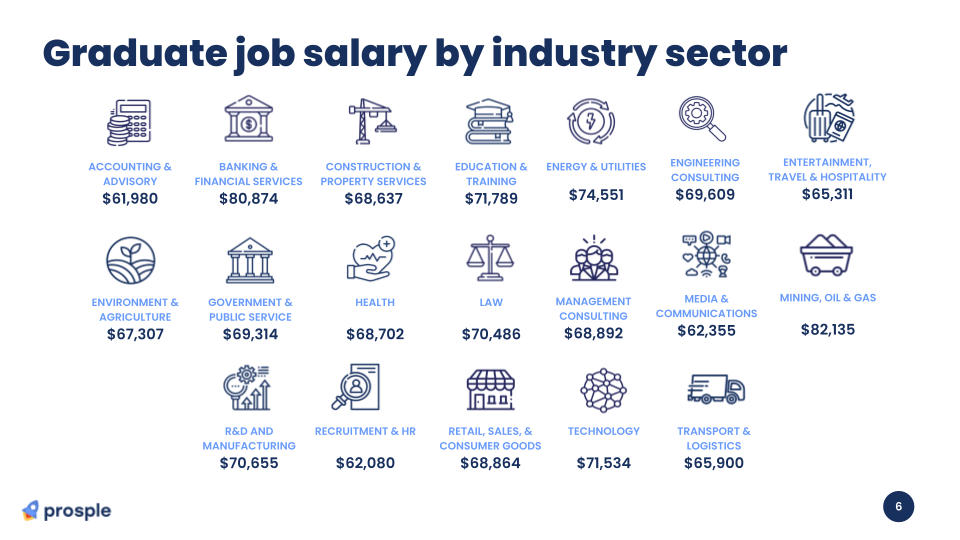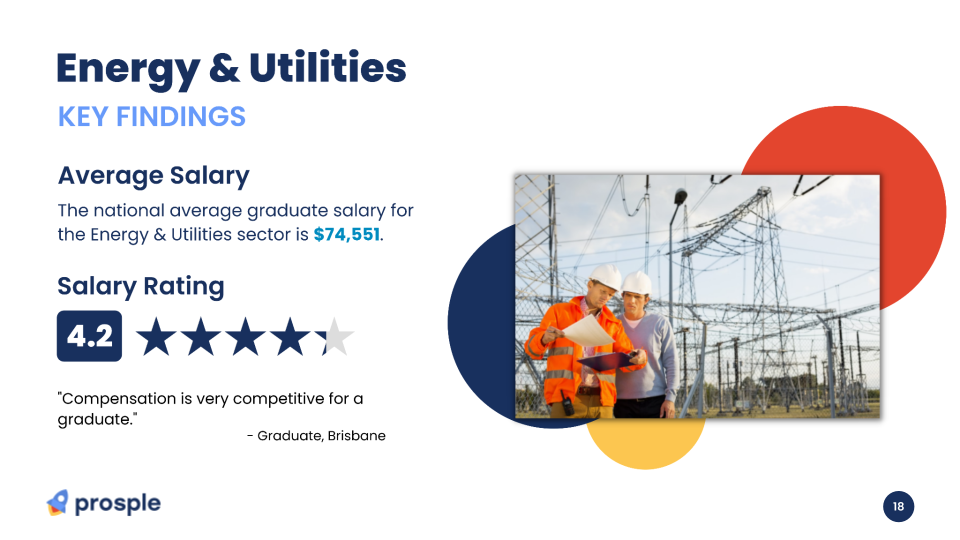Average graduate salaries in Australia (2023 update)
Jaymes Carr
Average graduate salaries in Australia
After finishing your degree—three, four, or even five years of study—it’s only natural that you should be curious about your reward. Fortunately, you don’t have to wonder whether or not it would be polite to ask current employees in your chosen field how much they earn: we’ve done the research for you.
We’ve collated the data from our Prosple database—which includes over 3,000 jobs and internships across the country from over 600 employers to give you an up-to-date information on average graduate salary accross industry sectors and states in Australia. So, if you’d like to know what your salary is likely to be as a graduate, read on to find out.
2023 average graduate salaries by industry sectors
Based on our database Mining, oil & gas industry offer the higest graduate salary with the average of $82,135 followed by Banking & Financial Services industry with the average of $80,874.
Here are the sectors listed from the most high-paying to the lowest paying:
- Mining, Oil, & Gas - $82,135
- Banking & Financial Services - $80,874
- Energy & Utilities - $74,551
- Education & Training - $72,789
- Technology - $71,534
- R&D Manufacturing - $70,655
- Law - $70,486
- Engineering Consulting - $69,609
- Government & Public Service - $69,314
- Management Consulting - $68,892
- Retail, Sales, & Consumer Goods - $68,864
- Health - $68,702
- Construction & Property Services - $68,637
- Environment & Agriculture - $67,307
- Transport & Logistics - $65,900
- Entertainment, Travel, & Hospitality - $65,311
- Media & Communications - $62,355
- Recruitment & HR - $62,080
- Accounting & Advisory - $61,980
2023 average graduate salaries by states
Graduate jobs located in Victoria (VIC) offer the highest salary with the average of $68,738 followed by Australian Capital Territory (ACT) with the average graduate salary of $68,195.
Gender, age, home language, and other factors
Published in August 2020, the Quality Indicators for Learning and Teaching (QILT) 2020 Graduate Outcomes Survey - Longitudinal shows how several factors impact graduate salaries. The QILT site features downloadable, extensive Excel tables if you'd like extra salary details, which is where the bulk of the following information comes from.
Gender
Notably, it demonstrates the persistence of a gender pay gap, with males earning a median salary 9.4 per cent higher ($80,000) than females ($73,100). This represents a substantial widening of the gap in the last three years, having been 4.3 per cent in 2017.
Age
Age has a positive impact on median starting salaries, with older graduates receiving significantly higher pay. For example, in 2020, the median salary for older graduates (i.e. those aged above 30) was $7,300 more per year in the short term (three months after graduation) and $6,900 in the long term (three years after graduation) than those aged 30 years or under.
Language and culture
In 2020, graduates who primarily spoke English at home earn a higher median salary ($60,000 in the short term; $75,000 long term) than those who speak a language other than English at home ($57,500 short; $71,000 long). After graduating, Indigenous Australians earn slightly more in the short term (median salary of $64,000) than non-Indigenous Australians ($60,000), but this evens out in the long term ($75,100 for Indigenous Australians; $75,000 for non-Indigenous).
Socioeconomic background
There were no published differences between socio-economic backgrounds in terms of median salary for 2020. There was some previously however; in 2018, those from high and medium socioeconomic brackets earned the same long-term median salary of $61,000. This was marginally higher than the median salary of graduates from low socioeconomic backgrounds ($60,500).
Location
The impact of location on salary reflects, perhaps, the influence of the high graduate salaries offered by businesses in the mining and engineering industries. Contrary to what one might expect, graduates in regional and remote areas enjoy a moderate advantage, earning a median salary of $67,600 in the short-term and $82,000 long (compared to $59,700 short and $74,100 long in metropolitan areas).
Disability
Reported disability actually correlates with a slight increase in median salary in the short-term, with those who report a disability earning $61,800, and those who don’t earning $60,000. This reverses in the long-term however, with those who report a disability earning $73,100 on average and those who don't earning $75,000.
Average graduate salaries over time
The QILT survey attracts the largest number of respondents, with 120,115 valid survey responses collected in 2020. In previous years, it has been similarly successful in surveying a cross-section of graduates from different universities, professions, and backgrounds. Hence, its summary of salary changes over time is relatively reliable and encouraging. In the twelve years leading to 2020, median starting salaries have increased steadily, from $45,000 in 2008 to $60,000 in 2020.
Common benefits
Of course, attractive salaries aren’t the only way in which graduate employers seek to attract top candidates. According to an AAGE survey, many will also offer various benefits, the most popular of which are employee assistance programs (offered by 93% of employers); flexible work arrangements (87%); a laptop, iPad, or netbook (68%); payment of course fees for further education (50%); staff discounts (47%); paid study leave (46%); and free or subsidised sport and leisure facilities (39%).
Finding out more about salaries at your target employer
When it comes to salaries, the one thing which can be difficult to learn is how much you can expect to earn at a specific organisation. Our 2023 Graduate salary guide summarise the insights we got from the graduates on how they rate their salary categorised by industry sector.
Based on our data, graduates in Energy & utilities industry rate their employer with the highest average rating of 4.2 out of 5.
Mining, oil & gas graduates rates their employer with the second higest rating of 4.1 out of 5.
If you want to find out more for each employer ratings you can browse employers on our website, navigating to graduate reviews, and selecting the salary tab, you can read about the pay and perks offered to graduates, as well as how satisfied current employees are to receive them. By gaining a sense of what you might earn, you’ll be able to manage your expectations and put yourself in a better position to negotiate. We hope you’re well compensated for your efforts!
Popular searches
Accounting Graduate Jobs & Programs
Business & Commerce Graduate Jobs & Programs
Engineering Graduate Jobs & Programs
Consulting Graduate Jobs & Programs
Graduate Jobs & Programs in Melbourne
Graduate Jobs & Programs in Sydney
Graduate Jobs & Programs in Brisbane
Graduate Jobs & Programs in Perth




